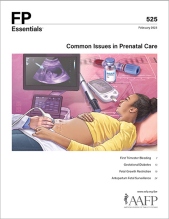
This clinical content conforms to AAFP criteria for CME.
Fetal growth restriction (FGR) is defined as an ultrasound (US)-determined estimated fetal weight or abdominal circumference less than the 10th percentile according to a population level reference curve. FGR affects up to 10% of pregnancies. Fetuses with FGR are at increased risk of intrauterine mortality and, postnatally, neonatal intraventricular hemorrhage, necrotizing enterocolitis, respiratory distress, hypoglycemia, and suboptimal neurologic, behavioral, and cognitive development. In early-onset FGR (ie, less than 32 weeks’ gestation), a detailed US examination is recommended. When FGR is accompanied by polyhydramnios and/or fetal anomalies, genetic testing should be obtained, including chromosomal microarray analysis. The timing of delivery strategy should be based on the severity of growth restriction and findings on fetal tests of well-being (eg, nonstress testing, umbilical artery Doppler velocimetry). No routine prevention strategies are recommended. However, it has been shown that daily low-dose aspirin (ie, 81 mg/day) reduces the risk of FGR when taken by patients with a high risk of preeclampsia.
Case 1, cont’d. At Sylvia’s routine 34-week prenatal visit, you document a fundal height of 30 cm (11.8 in). A bedside ultrasound (US) reveals normal amniotic fluid levels. A growth US is ordered, and the overall estimated fetal weight is at the 12th percentile according to the Hadlock curve. The abdominal circumference is in 6th percentile.
Background
Subscribe
From $350- Immediate, unlimited access to FP Essentials content
- 60 CME credits/year
- AAFP app access
- Print delivery available
Edition Access
$44- Immediate, unlimited access to this edition's content
- 5 CME credits
- AAFP app access
- Print delivery available
